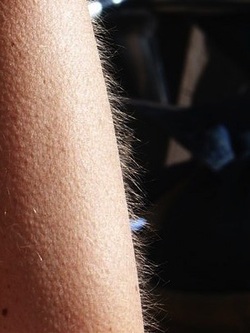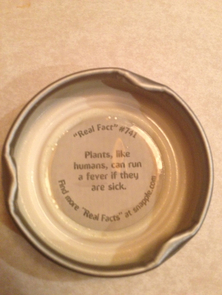|
If you've played with a Slinky for more than five minutes, you've probably mastered all the classic moves. But it turns out those humble coils have a surprise up their sleeves. Do this:
1) Dangle a Slinky above the ground as though you were holding a fish by the tip of its tail. 2) Let it extend to its full length. 3) Let go. For a fraction of a second, something amazing happens: the bottom of slinky hovers in midair, seeming to defy the laws of physics, while the top collapses toward it. Listen to the podcast here  So you know about vestigial traits? Organs or attributes that no longer serve their original purpose, but still haven't completely vanished...even though they're not really useful anymore. Like your appendix. I was recently looking into the topic and I came across a list of "10 Vestigial Traits You Didn't Know You Had." And there, alongside our tonsils and tailbones, and those tiny scraps of skin in the corners of our eyes that used to be full-on, horizontally opening-and-closing translucent third eyelids (like lizards have)...it sat: Goose bumps. Now, I never thought of goose bumps as a vestigial trait. I thought of goose bumps as cool-looking, sure. Neato. But kind of pointless. It turns out, however, these little flashing studs of flesh used to do something very specific (and useful!) for us. Think about when goose bumps occur: when you’re cold or really freaked out (Was that a ghost!? Ah. Goose bumps). Turns out those tiny domes are just evidence of the Arrector Pili muscles flexing. The Arrector Pili muscles are the tiny muscles in your dermis which connect to your hair follicles. Now, long ago, when you were covered with a nice thick coat of fur, the effect of such a contraction would be a magical POOF! Tada, you are now a giant fur-ball. Like a cat with its hair standing on end, but human-sized. Now it turns out there are two reasons hair standing on end is useful to a creature:
It’s this second effect that made me smile. Because then I thought about the third thing which gives us goose bumps -- feeling so moved by something...something so sweet or sad or hopeful...that a wave of ripples appears on our skin. I never knew why that happened, though I’ve always loved it when it did. Proof, in cutaneous puckering, of just how much a story affected me. Now I see there might be a far more specific reason for this reaction. Perhaps when a story has a turn that’s so overwhelmingly powerful, it makes us feel humbled, literally: we feel small in the face of it. That little pulse of skin is an attempt to flex that long-lost coat of fur, an attempt to protect us. But not from some creature of massive strength -- not a sharp-taloned, razor-fanged predator -- but from Hope itself. Right? When I think about what brings on these "emotional" goose bumps -- what precisely is it that triggers them? -- I think it's moments of blindsiding hope. A jack-in-the-box surprise amount of human goodness. Lovers waiting for each other against all odds. That sort of thing. Is it the same for you? Next time you get goose bumps because of someone’s story, or music, or art, whatever it is, try to note SPECIFICALLY what it was that did it. We’d love it if you’d share. Either way, enjoy that phantom shield -- that ancient mechanism there inside you trying to make you look bigger than you are. By Lulu Miller source  Mrs Ciasulli did you know: "Plants, like humans can run a fever if they are sick" ? We have known this for a long time (like the 1950's) but the mechanism is not understood. Infected plants were compared to uninfected plants. The infected leaves had an increased rate of gas exchange which led to an increased temp. Is this evolution? Higher temperatures prevent RNA transcription of a virus. Since plants do not produce antibodies, maybe this is their only alternative? -Loriann Ciasulli TIL that plants, when they've absorbed enough sunlight, can "switch off" their photosynthesis.11/19/2012  Scientists unravel plants' natural defenses A team of researchers has discovered how plants protect their leaves from damage by sunlight when they are faced with extreme climates. The new findings, which have been published in Nature, could have implications both for adapting plants to the threat of global warming and for helping man better harness solar energy. Photosynthesis in plants relies upon the efficient collection of sunlight. This process can work even at low levels of sunlight, when plants are in the shade or under cloud cover for example. However, when the sun is very bright or when it is cold or very dry, the level of light energy absorbed by leaves can be greatly in excess of that which can be used in photosynthesis and can destroy the plant. However, plants employ a remarkable process called photoprotection, in which a change takes place in the leaves so that the excess light energy is converted into heat, which is harmlessly dispersed. Until now, researchers hadn't known exactly how photoprotection works. By joining forces with their physicist colleagues in France and the Netherlands, the UK team have determined how this process works. They were able to show how a small number of certain key molecules, hidden among the millions of others in the plant leaf, change their shape when the amount of light absorbed is excessive; and they have been able to track the conversion of light energy to heat that occurs in less than a billionth of a second. Many plant species can successfully inhabit extreme environments where there is little water, strong sunlight, low fertility and extremes of temperature by having highly tuned defence mechanisms, including photoprotection. However, these mechanisms are frequently poorly developed in crop plants since they are adapted for high growth and productivity in an environment manipulated by irrigation, fertilisation, enclosure in greenhouses and artificial shading. These manipulations are not sustainable, they have high energy costs and may not be adaptable to an increasingly unstable climate. Researchers believe that in the future, the production of both food and biofuel from plants needs to rely more on their natural defence mechanisms, including photoprotection. Professor Horton, of the University of Sheffield's Department of Molecular Biology and Biotechnology, who lead the UK team, said: "These results are important in developing plants with improved photoprotective mechanisms to enable them to better cope with climate change. This may be hugely significant in our fight against global warming. It is a fantastic example of what can be achieved in science when the skills of biologists and physicists are brought together." Moreover, there are other global implications of this research. Dr Alexander Ruban of Queen Mary's School of Biological and Chemical Sciences, comments: "As we seek to develop new solar energy technology it will be important to not only understand, but to mimic the way biology has learnt to optimise light collection in the face of the continually changing intensity of sunlight." source |
This is a collection of interesting facts collected from the internet. Archives
September 2015
Categories |

 RSS Feed
RSS Feed
